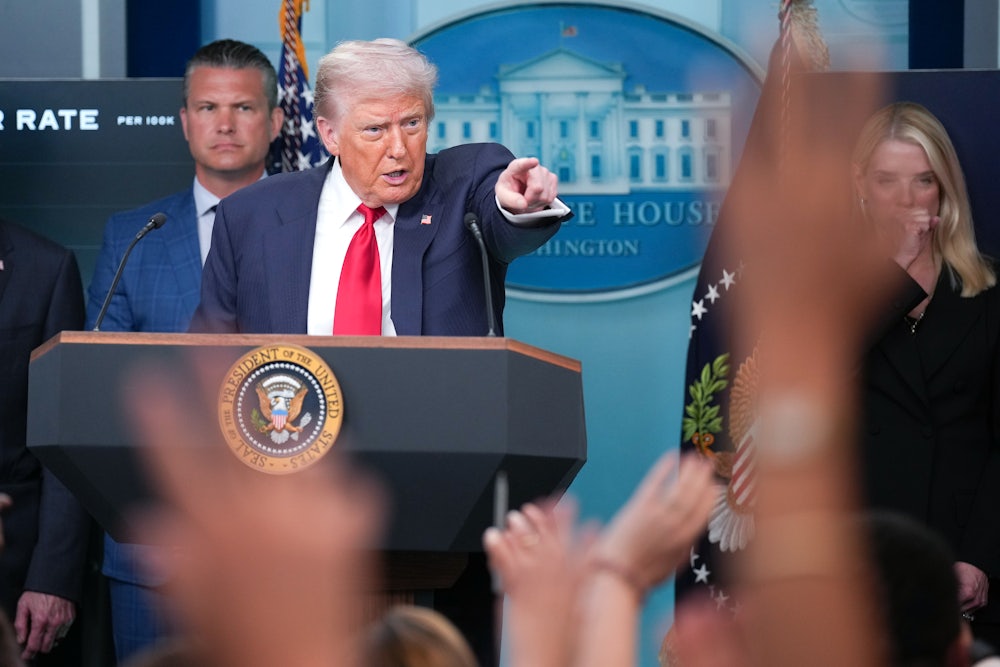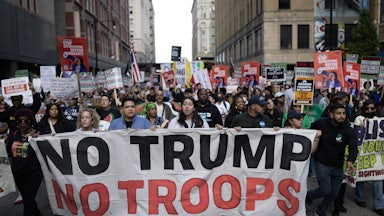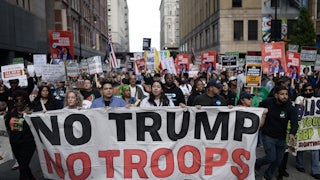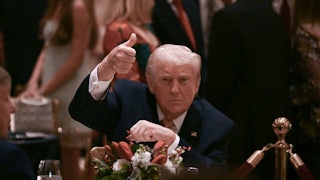President Donald Trump seized control of the District of Columbia’s municipal police force on Monday and deployed hundreds of federal agents and National Guard soldiers onto the capital’s streets in an authoritarian show of force.
In a statement, the White House proclaimed that Trump had “taken bold executive action to liberate Washington, D.C., from the cesspool of crime and homelessness that it has become after decades of unilateral Democrat leadership.” Trump himself told reporters during a press briefing that Monday should be regarded as “Liberation Day,” a phrase he last used for the announcement of high tariff rates that sent stock markets tumbling this spring.
The repurposing of the slogan of a past failure is telling. Monday’s move comes as the Trump administration finds itself struggling on a host of other policy fronts. Recent economic data showed that hiring is slowing amid the president’s trade wars, which prompted Trump to fire the Bureau of Labor Statistics commissioner earlier this month. Trump and the Justice Department continue to resist calls to release the Epstein files, which reportedly describe Trump’s politically damaging friendship with deceased child-sex-trafficker Jeffrey Epstein.
Early indications suggest that Trump’s latest brainwave is more performative than substantive. One social media user filmed Drug Enforcement Agency agents patrolling the National Mall in full Kevlar gear on Monday morning. The greatest public safety threat that they will likely encounter there are the high prices for the nearby ice cream trucks that cater to passing tourists.
At the same time, it is utterly futile to ask whether this operation is really meant to reduce crime in D.C., whether it is a trial run for some future authoritarian maneuver, or whether it is a distraction from all of the administration’s other setbacks and scandals. For fascists, shows of armed force are both a means and an end. At minimum, the White House will create some good B-roll footage for Fox News broadcasts to use when hyping fears of urban crime.
The plan to take over the city’s police force began last week after Edward Coristine, a 19-year-old former DOGE staffer who now works for the Social Security Administration, was allegedly assaulted in a late-night attack near Dupont Circle. Police reports said that he was attacked by as many as 10 teenagers, with officers later apprehending two of them.
D.C. experienced an unusual surge in violent crime in 2023, which prompted widespread concern among district and federal leaders. Local crime statistics suggest that the district has turned a corner since then. The Justice Department reported in January that homicides and robberies had dropped by one-third since the post-pandemic peak, with armed carjackings down by half and some assaults at their lowest level in three decades.
Pointing to overall crime statistics and long-term trends is a fool’s errand, however, since all it takes is a handful of incidents for the White House to claim a crackdown is needed. Trump posted a photo of Coristine’s bruised and bleeding face on his personal social media platform shortly after last week’s incident and promised action.
“If D.C. doesn’t get its act together, and quickly, we will have no choice but to take Federal control of the City, and run this City how it should be run, and put criminals on notice that they’re not going to get away with it anymore,” the president wrote. “Perhaps it should have been done a long time ago, then this incredible young man, and so many others, would not have had to go through the horrors of Violent Crime. If this continues, I am going to exert my powers, and FEDERALIZE this City.”
Trump’s threat to “federalize” D.C. is nonsensical on its face. The District of Columbia is a federal enclave under Congress’s control, not the president’s. In one sense, it has been federalized ever since George Washington, who—borrowing from his ample experience as a land speculator in the region—helped select the 10-square-mile district’s location during his presidency. Congress formally established the enclave in 1801 and experimented with a variety of different governance structures for the city’s residents over the years.
In 1973, federal lawmakers enacted the Home Rule Act to allow D.C. to govern itself through an elected mayor and a City Council, similar to those found in other major cities. Richard Nixon, the president at the time, said that he supported the measure as part of his administration’s overall commitment to promote local governance. D.C. residents had previously received the right to vote in presidential elections through the Twenty-Third Amendment; they still lack congressional representation to this day.
Though D.C. is Congress’s responsibility, Trump does have unique powers within the district that he does not enjoy elsewhere. When the president staged a major immigration enforcement operation in Los Angeles earlier this summer, for example, he was able to federalize the state National Guard and send in federal agents from around the country to carry out various raids and suppress protests. At the same time, he had no legal authority to conscript California’s civilian state and local law enforcement agencies to assist him.
D.C. is different. Among the Home Rule Act’s provisions is Section 740, which allows the president to commandeer the Metropolitan Police Department, in whole or in part, whenever he concludes that “special conditions of an emergency nature” require it. The president’s control can only last for 48 hours unless he provides written notice and explanation to the House and Senate leadership of the committees that oversee D.C. governance. From there, the president has control over the MPD for a full month.
The House and Senate can choose to extend a president’s control for longer by passing a joint resolution to authorize it. The Home Rule Act does not provide any further limits beyond that; its drafters apparently did not envision that an authoritarian president would hold office and misuse the emergency powers. If Congress does not act, it is unclear whether Trump could simply seize control of the D.C. police in 30-day increments for the remainder of his presidency.
This is a far cry from “federalizing” the district, even if one sets aside the misconception behind that term. D.C.’s civilian government remains intact and operational. D.C. Attorney General Brian Schwalb claimed in a post on Twitter on Monday that Trump’s actions were “unprecedented, unnecessary, and unlawful” and suggested, without elaboration, that district officials were “considering all their options” on a potential response.
Mayor Muriel Bowser, who has adopted a conciliatory stance with the Trump administration since its return in January, said that she “can’t say we were totally surprised” by Monday’s announcement. She also described it as “unsettling and unprecedented,” then tried to emphasize recent reductions in violent crime that showed Trump’s intervention was unnecessary.
For Trump and his supporters, the actual reduction in crime in the nation’s capital is probably beside the point. His public remarks depicted the nation’s capital as covered in “filth and decay” and overrun by “tents, squalor, filth, and crime.” The reality does not matter, only the fascist spectacle that he can manufacture and sell to Fox News viewers. Conservatives have worked tirelessly to convince themselves that urban areas are terrifying and that Democrats are synonymous with crime and disorder.
In his comments on Monday, the president even suggested that he would allow the police officers now under his command to abuse citizens at will. “The police are standing and they’re told, ‘Don’t do anything under any circumstances,’” he said, perhaps referring to protesters of some kind. “And you can see they want to get at it. And they’re standing there, and people are spitting in their face, and they’re not allowed to do anything. But now they are allowed to do whatever the hell they want.” Well, at least for the next 30 days.










